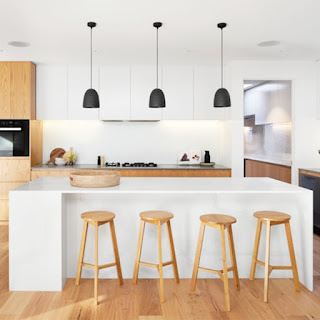Harmonizing Spaces Elevate Your Home/Office with the Rhythms of Design
Continuing our journey through the Principles and Elements of Designing, we transition from the concept of balance to the captivating principle of rhythm. Much like its musical counterpart, rhythm in design possesses a profound essence, bringing life and vibrancy to spaces.
In the context of design, rhythm unfolds through the repetition of elements, forming a visual cadence that reverberates throughout a room. The intervals between these recurring elements contribute to an overall sense of rhythm, guiding the viewer's gaze effortlessly from one object to the next
Rhythm can be classified into three types as follows,
1. Regular Rhythm or Repetition
True to its name, regular rhythm
takes shape through consistent repetition of elements such as light, color,
pattern, texture, form, proportion, and scale. In the showcased kitchen
setting, pendant lights and stools exhibit a perfect illustration of regular
rhythm. Positioned at regular intervals, these elements create a visually
pleasing and cohesive rhythmic pattern.
2. Flowing Rhythm or Alternation
Flowing rhythm unfolds when
alternating elements contribute to the overall design, whether in color and
form, texture and form, or color and shape. The living room pictured below exemplifies flowing
rhythm through the repetition of the square shape. Nearly all objects featuring
this square shape, combined with a consistent wooden texture, establish a
harmonious and flowing rhythm that ties the room together.
3. Progressive Rhythm
Progressive rhythm emerges through
the gradual progression of one or more elements, achieved through color
gradation or a sequence of objects evolving from small to large. In the
provided image, color and form collaborate to establish a progressive rhythm,
with a gradual change in form, starting small and evolving into larger
elements. The circular design around the mirror and the progression in the size
of kettles below it exemplify the concept of progressive rhythm.
The practical application of these
principles strengthens the learning process. Now, let's engage in a
participatory exercise.
Feel free to share your answer in the comment box below, along with any suggestions or recommendations.
As we unveil the secrets of design, the rhythmic elements within your space can transform it into a visual symphony. Adding new music to your home or office involves understanding and applying the principles of rhythm, creating an environment resonating with harmony and aesthetic appeal.
Discover
the transformative power of design with architect
and interior designer Anjali Nandkumar.
Explore online interior design courses on Udemy and enhance your skills in residential interior design. Elevate your understanding and
application of design principles
today.






.jpg)

Comments
Post a Comment